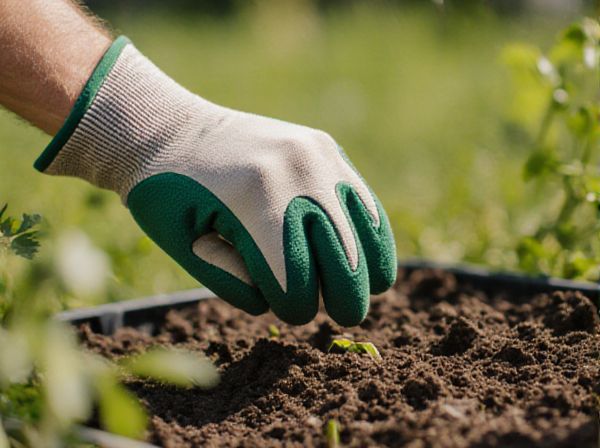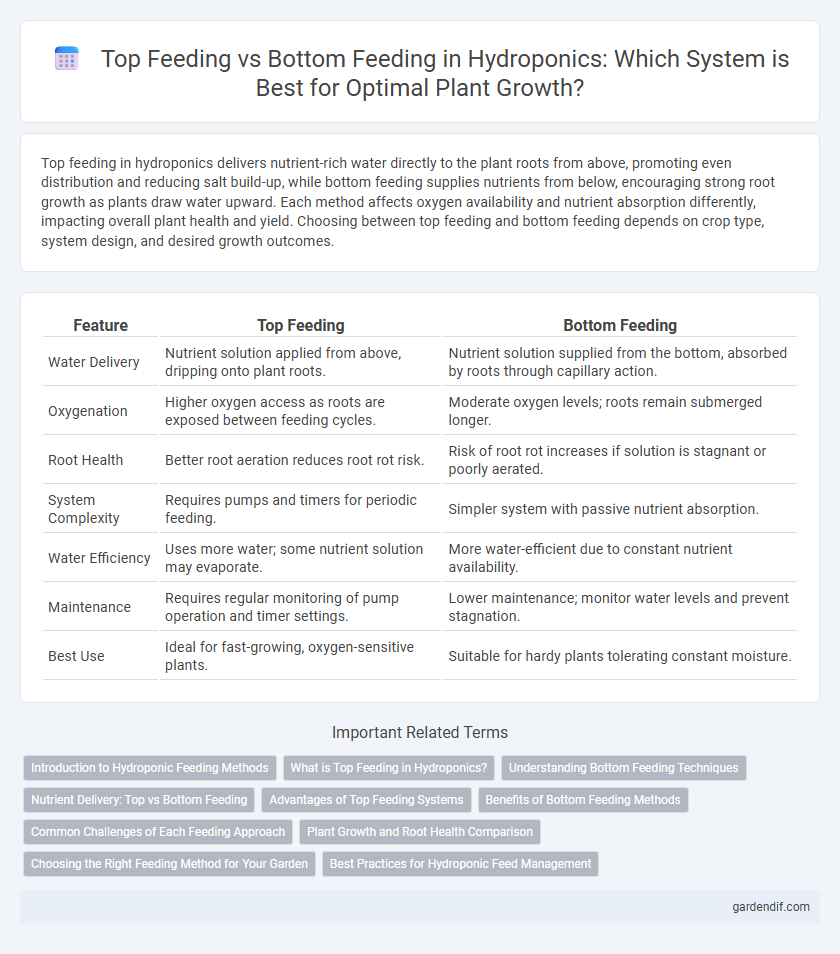
Top Feeding vs Bottom Feeding Illustration
Top feeding in hydroponics delivers nutrient-rich water directly to the plant roots from above, promoting even distribution and reducing salt build-up, while bottom feeding supplies nutrients from below, encouraging strong root growth as plants draw water upward. Each method affects oxygen availability and nutrient absorption differently, impacting overall plant health and yield. Choosing between top feeding and bottom feeding depends on crop type, system design, and desired growth outcomes.
Table of Comparison
| Feature | Top Feeding | Bottom Feeding |
|---|---|---|
| Water Delivery | Nutrient solution applied from above, dripping onto plant roots. | Nutrient solution supplied from the bottom, absorbed by roots through capillary action. |
| Oxygenation | Higher oxygen access as roots are exposed between feeding cycles. | Moderate oxygen levels; roots remain submerged longer. |
| Root Health | Better root aeration reduces root rot risk. | Risk of root rot increases if solution is stagnant or poorly aerated. |
| System Complexity | Requires pumps and timers for periodic feeding. | Simpler system with passive nutrient absorption. |
| Water Efficiency | Uses more water; some nutrient solution may evaporate. | More water-efficient due to constant nutrient availability. |
| Maintenance | Requires regular monitoring of pump operation and timer settings. | Lower maintenance; monitor water levels and prevent stagnation. |
| Best Use | Ideal for fast-growing, oxygen-sensitive plants. | Suitable for hardy plants tolerating constant moisture. |
Introduction to Hydroponic Feeding Methods
Hydroponic feeding methods primarily include top feeding and bottom feeding, each delivering nutrient solutions differently to plants. Top feeding involves applying nutrient-rich water directly to the plant roots from above, promoting oxygenation and nutrient absorption on the root surface. Bottom feeding, on the other hand, supplies nutrients from beneath the root zone, encouraging roots to grow downward into the nutrient reservoir for sustained uptake and reduced risk of overwatering.
What is Top Feeding in Hydroponics?
Top feeding in hydroponics refers to the method where nutrient solution is delivered directly to the surface of the growing medium or plant roots from above. This technique ensures even moisture distribution and promotes optimal oxygen availability to the root zone. Commonly used in systems like ebb and flow or drip irrigation, top feeding supports healthy plant growth by maintaining consistent nutrient delivery.
Understanding Bottom Feeding Techniques
Bottom feeding techniques in hydroponics involve delivering nutrient solutions directly to the roots from below, promoting efficient oxygenation and nutrient absorption. This method reduces the risk of algae growth on the water surface and enhances root aeration, leading to healthier plant development. Systems like ebb and flow or nutrient film technique (NFT) utilize bottom feeding to optimize water and nutrient delivery for various crops.
Nutrient Delivery: Top vs Bottom Feeding
Top feeding delivers nutrient-rich water directly to the plant roots from above, ensuring even distribution and better oxygenation, which promotes faster growth. Bottom feeding supplies nutrients from below by allowing roots to absorb water through capillary action, creating a consistent moisture level and reducing the risk of overwatering. Both methods affect nutrient uptake efficiency, with top feeding providing more control over nutrient concentration and bottom feeding optimizing root zone hydration.
Advantages of Top Feeding Systems
Top feeding hydroponic systems promote uniform nutrient distribution directly to plant roots, enhancing oxygen availability and reducing root diseases. These systems allow precise control over water and nutrient delivery, optimizing growth rates and minimizing waste. Easy monitoring and maintenance of the nutrient solution make top feeding ideal for high-yield, commercial hydroponic setups.
Benefits of Bottom Feeding Methods
Bottom feeding hydroponic systems provide consistent nutrient delivery directly to plant roots, enhancing oxygen availability and reducing the risk of nutrient burn. This method promotes healthier root development by maintaining stable moisture levels and preventing waterlogging commonly seen in top feeding systems. Additionally, bottom feeding reduces water waste and increases nutrient uptake efficiency, resulting in faster plant growth and higher yields.
Common Challenges of Each Feeding Approach
Top feeding systems often struggle with uneven nutrient distribution and root exposure to drying air, causing inconsistent plant growth and potential nutrient deficiencies. Bottom feeding methods can face issues with waterlogging and root rot due to constant exposure to standing nutrient solutions, leading to oxygen deprivation for roots. Both approaches require precise monitoring of nutrient concentration and pH balance to optimize plant health in hydroponic setups.
Plant Growth and Root Health Comparison
Top feeding hydroponic systems deliver nutrient solutions directly to the plant roots from above, promoting even moisture distribution and reducing the risk of root rot, which supports vigorous plant growth and healthy root development. Bottom feeding enhances aeration by allowing nutrient uptake through capillary action, fostering a robust root system with improved oxygen availability, crucial for nutrient absorption and overall plant vitality. Comparing both, top feeding is typically more effective for faster nutrient delivery, while bottom feeding excels in maintaining root health and preventing waterlogging, making the choice dependent on specific plant needs and system design.
Choosing the Right Feeding Method for Your Garden
Top feeding delivers nutrient solution directly to the plant roots, promoting oxygen access and reducing root rot risks, making it ideal for fast-growing crops. Bottom feeding allows roots to absorb nutrients through a porous medium, conserving water and minimizing nutrient runoff, suited for steady-growing plants. Selecting between these methods depends on plant type, growth rate, and water management preferences to optimize hydroponic garden productivity.
Best Practices for Hydroponic Feed Management
Top feeding hydroponic systems provide nutrients directly to the root zone via surface irrigation, promoting oxygenation and reducing nutrient lockout, while bottom feeding utilizes capillary action or wicking to draw nutrients upward, conserving water and minimizing algae growth. Best practices for hydroponic feed management include monitoring pH levels within the optimal range of 5.5 to 6.5, maintaining electrical conductivity (EC) between 1.2 to 2.0 mS/cm to ensure nutrient balance, and scheduling feed cycles to prevent root oxygen deprivation. Employing automated timers and sensors enhances precision in nutrient delivery, improves plant health, and maximizes yield efficiency.
Top Feeding vs Bottom Feeding Infographic

 gardendif.com
gardendif.com